The global financial world is changing fast. More and more people now use online banking and are exploring new things like cryptocurrency. To meet the needs of this new world, a platform called CrossFi has been developed. CrossFi combines the reliability of traditional finance (TradFi) with the innovation of decentralized finance (DeFi). It aims to make financial systems easier to use, safer, and more efficient by bringing together the best of both worlds.
In this article, we’ll look at CrossFi’s features and how it might change how we use and think about money in the future.
Understanding the CrossFi Ecosystem
CrossFi offers a range of services designed to help people manage their money in a modern way. It uses blockchain technology, a secure digital system, to create a reliable network for financial transactions.
The CrossFi Chain
At the heart of the CrossFi ecosystem is the CrossFi Chain, which is a Layer 1 blockchain. Think of it as the main foundation or building block of CrossFi’s system. The CrossFi Chain has a structure that makes it very fast and secure. It uses something called Proof-of-Stake, which is a way to confirm transactions and make sure everything is correct on the network. This system is made up of two important parts:
- Cosmos (Tendermint Core, Cosmos SDK): This part of the system helps build the blockchain quickly and securely. Tendermint Core, which is the engine for this part, is known for its speed and security. It also has a feature to block any bad actions, like hacking attempts, to keep the data safe. This makes transactions fast and protects everyone’s information.
- Ethereum Compatibility with Ethermint and Evmos: CrossFi also includes a part called Ethermint, which allows it to work with the Ethereum network. Ethereum is one of the most popular blockchain networks, and by using Ethermint, CrossFi can connect with Ethereum’s smart contracts (programs that run on the blockchain) and its DeFi services. This makes it easy for CrossFi users to interact with other popular crypto systems. Evmos, a tool that works with Ethermint, helps make this connection smoother.
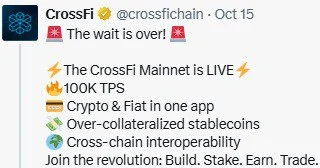
CrossFi has built its blockchain to handle up to 100,000 transactions per second, which is impressive. This means it can support a lot of users and still be fast and secure.
CrossFi Mainnet Launch
The official launch of the CrossFi network, called the Mainnet, happened on October 15. This launch was an important step as it unlocked all the features of CrossFi’s blockchain. Here’s why the Mainnet launch is important:
- Engaging with Real Assets: Users can securely engage with real assets on the CrossFi network. For example, when they do things like staking or providing liquidity, they are dealing with tokens that have actual value.
- Wide Range of Applications: CrossFi offers different financial activities within its ecosystem, such as apps for staking, liquidity mining, and trading assets. Users can earn returns by using their XFI tokens in these activities.
- High Security: The Mainnet is built to handle a large number of users and high-value transactions securely, making it a reliable platform.
- Cross-Chain Compatibility: CrossFi’s system is designed to work with other blockchains, making it easy to connect with other networks and expand the platform’s capabilities.
CrossFi Foundation
The CrossFi Foundation is a non-profit organization that supports the growth of the CrossFi ecosystem. The Foundation offers grants to developers and rewards for users, giving out around $50 million in rewards to help the network grow. For example, they give rewards to early users who help test the system. This funding encourages people to join and improve the network, making CrossFi stronger and more innovative.
CrossFi App and xApp
CrossFi has two main applications to serve different types of users:
CrossFi App
The CrossFi App works like a decentralized bank. It allows users to manage both traditional currency (like dollars) and cryptocurrency (like Bitcoin) in one place. Users can also make international payments using the app. One key feature is the non-custodial payment method, meaning users have complete control of their crypto assets. They can use CrossFi VISA cards for payments, either virtual or physical.
Some other features of the CrossFi App include:
- Competitive Exchange Rates: Users can exchange currency at good rates.
- Multi-Currency Cards: Users can create and manage cards with multiple currencies.
- POS Terminals and ATM Integration: The app offers solutions for payments, including integration with ATMs and trading terminals.
CrossFi xApp
The CrossFi xApp is designed for users who are more experienced with cryptocurrency. It has features that help users grow their digital assets, such as:
- Smooth Token Swaps: Users can quickly swap different tokens within the CrossFi Chain network.
- Cross-Chain Asset Transfers: This makes it easier to move assets between different blockchain networks.
- Staking Options: The xApp has a system where users can stake (lock up) their tokens to earn rewards and help secure the network.
The xApp also lets users create and lend an algorithmic stablecoin called XUSD, which is pegged to the value of the US dollar.
Key Features of the xApp
The CrossFi xApp has several important features, including:
- Liquidity: It uses Sushi’s liquidity pools to make it easy to acquire XFI tokens across different blockchains.
- Swap Function: Users can quickly exchange tokens like XUSD, USDT, and XFI.
- Bridge: This feature lets users transfer assets across different blockchains.
- Stake: Users can stake different types of tokens to earn rewards.
- Rewards System: The system offers rewards to active participants in the CrossFi ecosystem.
- Escrow and Stablecoin: The xApp provides additional rewards for long-term users and allows them to mint a stablecoin, XUSD.
CrossFi Tokens
CrossFi’s ecosystem uses two main types of tokens to keep the system running smoothly and reward users:
Mint Power (MPX): MPX is a governance token that allows users to participate in decision-making. It’s also used to secure the network through staking.
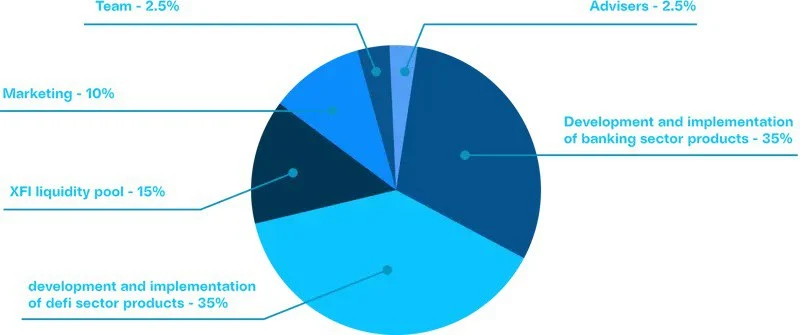
CrossFi (XFI): XFI is the main utility token for the CrossFi system, used for various DeFi applications in the CrossFi xApp and for payments in the CrossFi App.
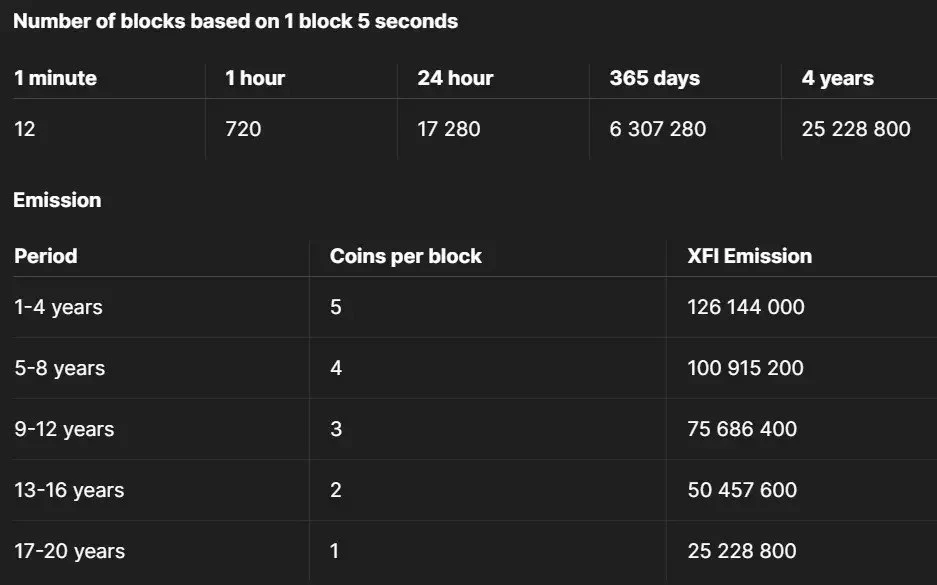
CrossFi also introduced an EVM-compatible token called eMPX, which allows MPX token holders to use their tokens in the Ethereum network.
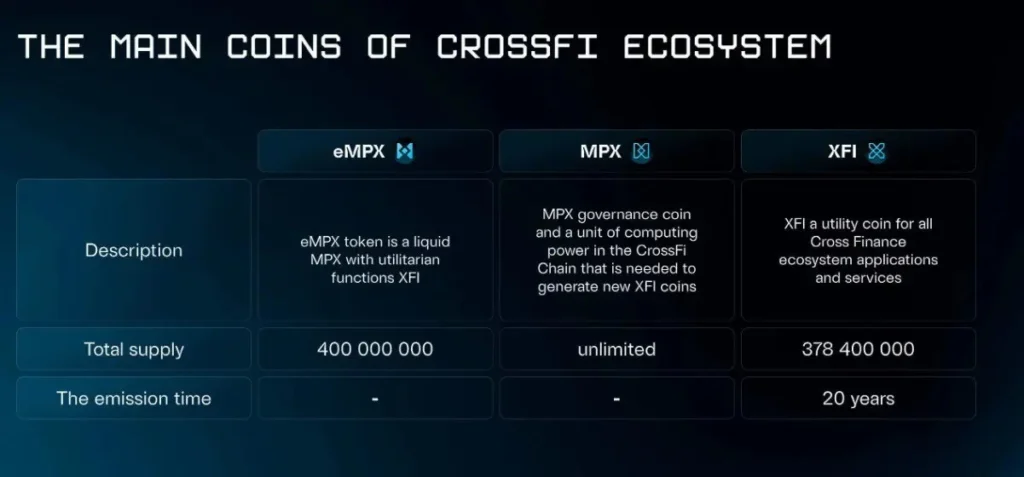
CrossFi’s Partnerships
CrossFi has partnered with major companies in the blockchain industry to support and grow its platform. Some key partners include:
- Alchemy: A platform that helps developers create and grow decentralized applications.
- Covalent: A service that provides detailed information on blockchain activities.
- DIA: A decentralized oracle that provides reliable data for DeFi applications.
- Blast RPC: Offers fast and reliable connectivity to decentralized networks.
- DeBridge: Supports cross-chain communication, making it easier to transfer assets across blockchains.
- CoinList: A platform that helps launch tokens and generate liquidity for CrossFi’s native token XFI.
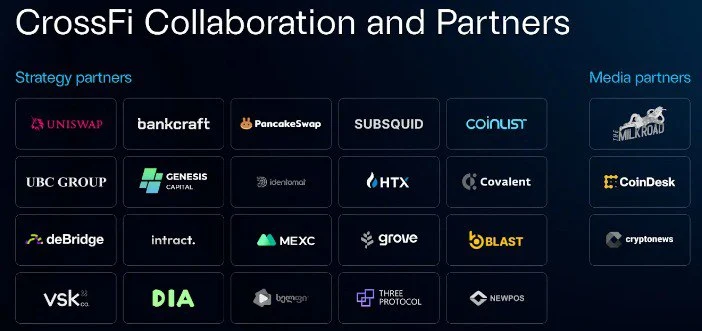
These partnerships help strengthen CrossFi’s ecosystem and make it more accessible and efficient.
The CrossFi Team
CrossFi is led by a team of experts in finance, technology, and marketing. Here are a few key team members:
- Alexander Mamasidikov: The CEO and main coordinator, with expertise in cryptocurrency and digital marketing.
- Fyodor Bogorodsky: The Chief Financial Advisor with 27 years of experience in banking.
- Phillip Alexeev: Chief Growth Officer, with over 10 years of experience in growth marketing.

This experienced team is dedicated to making CrossFi a leader in decentralized finance.
Technical Analysis of XFI Token
The price of CrossFi’s native token, XFI, is around $0.82, with a circulating supply of over 42 million. If the price remains stable, it might increase to $1 or even $2 in the future.
Final Thoughts
CrossFi is paving the way for a future where cryptocurrencies are easy to use in daily life. It combines the strengths of traditional and decentralized finance to create a financial system that’s accessible, secure, and efficient. With its focus on user control and innovation, CrossFi could lead the way in bridging the gap between crypto and traditional finance.
